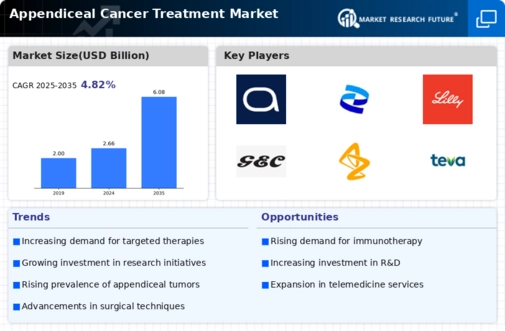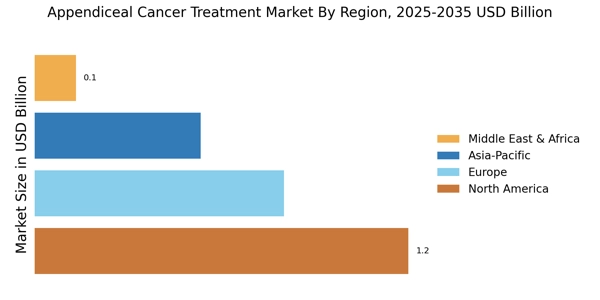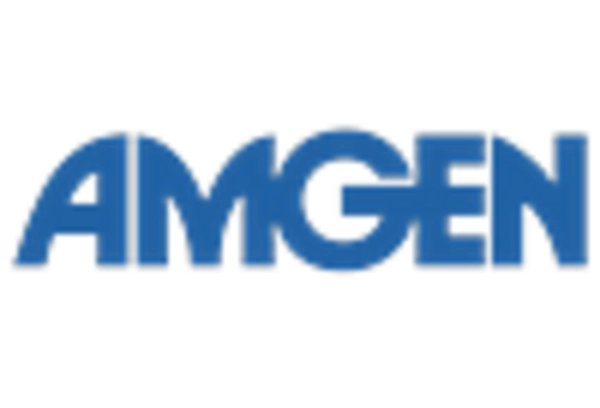Emergence of Personalized Medicine
The emergence of personalized medicine is a transformative driver for the Appendiceal Cancer Treatment Market. Tailoring treatment plans based on individual genetic profiles and tumor characteristics is becoming increasingly feasible, thanks to advancements in genomic testing and biomarker identification. This approach allows for more effective and targeted therapies, which may enhance treatment efficacy and minimize adverse effects. As healthcare providers adopt personalized medicine strategies, the demand for specialized diagnostic tools and targeted therapies is likely to rise. This shift towards individualized treatment is expected to reshape the landscape of the Appendiceal Cancer Treatment Market, as stakeholders prioritize research and development efforts to create therapies that cater to the unique needs of appendiceal cancer patients. The potential for improved patient outcomes through personalized approaches may drive further investment in this area.
Advancements in Surgical Techniques
Advancements in surgical techniques represent a significant driver for the Appendiceal Cancer Treatment Market. Minimally invasive procedures, such as laparoscopic surgery, have gained traction in recent years, offering patients reduced recovery times and lower complication rates. These innovations are likely to enhance the overall treatment experience for appendiceal cancer patients. Furthermore, the integration of robotic-assisted surgery is becoming more prevalent, allowing for greater precision and control during operations. As these techniques continue to evolve, they may lead to improved patient outcomes and increased survival rates, thereby stimulating demand within the Appendiceal Cancer Treatment Market. The ongoing training and education of surgical teams in these advanced methods are also expected to contribute to the market's growth, as more healthcare facilities adopt these technologies.
Growing Investment in Cancer Research
Growing investment in cancer research is a pivotal driver for the Appendiceal Cancer Treatment Market. Increased funding from both public and private sectors has led to significant advancements in understanding the biology of appendiceal cancer. This influx of resources is facilitating the development of novel therapies, including immunotherapy and targeted treatments, which are showing promise in clinical trials. As research continues to unveil new insights into the disease, the potential for innovative treatment options expands, thereby attracting more stakeholders to the market. The collaboration between academic institutions and pharmaceutical companies is likely to accelerate the pace of discovery, ultimately benefiting patients and healthcare providers alike. This trend underscores the importance of sustained investment in cancer research to enhance the Appendiceal Cancer Treatment Market.
Rising Incidence of Appendiceal Cancer
The rising incidence of appendiceal cancer is a critical driver for the Appendiceal Cancer Treatment Market. Recent data indicates that the incidence rate of appendiceal cancer has been increasing, with estimates suggesting that it affects approximately 1.2 per 100,000 individuals annually. This upward trend necessitates the development and availability of effective treatment options, thereby propelling market growth. As awareness of this rare cancer type increases, healthcare providers are more likely to invest in innovative therapies and treatment modalities. The growing patient population is expected to drive demand for specialized treatment centers and advanced surgical techniques, further enhancing the Appendiceal Cancer Treatment Market. Consequently, stakeholders are likely to focus on research and development to address the unique challenges posed by this malignancy.
Rising Awareness and Education Initiatives
Rising awareness and education initiatives are crucial drivers for the Appendiceal Cancer Treatment Market. Increased public and professional awareness about appendiceal cancer is leading to earlier diagnosis and treatment, which is essential for improving patient outcomes. Various organizations and healthcare providers are actively engaging in campaigns to educate both patients and clinicians about the signs and symptoms of this rare cancer. This heightened awareness is likely to result in more individuals seeking medical attention sooner, thereby increasing the demand for treatment options. Additionally, educational programs aimed at healthcare professionals are fostering a better understanding of the disease, which may lead to improved referral patterns and treatment strategies. As awareness continues to grow, the Appendiceal Cancer Treatment Market is expected to benefit from a more informed patient population.

















